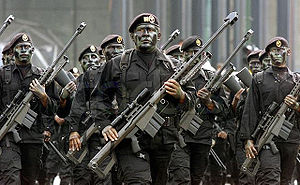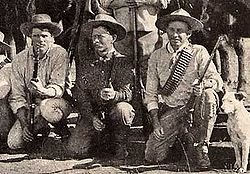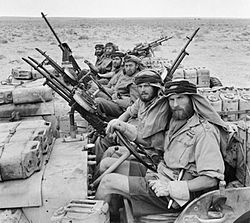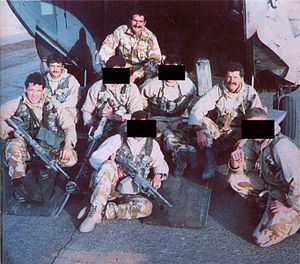- Special forces
-
 Mexican special forces
Mexican special forces
- Further information: List of special forces units and List of defunct special forces units; Not to be confused with Special Troops Battalion
Special forces, or special operations forces are terms used to describe elite military tactical teams trained to perform high-risk dangerous missions that conventional units cannot perform. Special forces soldiers need to be physically and mentally robust and have the confidence, courage, and skill to operate individually or in small teams, often in isolation and in a hostile environment.[1] They are high-value assets commanded at the strategic level, delivering effects disproportionate to their size.[2]
Contents
Evolution
Structured military activities have always required the support of specialised assets providing additional capabilities, some of which now come under the umbrella of what are now described as special forces capabilities. The tactics and techniques used by these assets may have remained the preserve of specialist units or be cascaded out to more standard units over time.
Special forces, as they would now be recognised, emerged in the early 20th century, with a significant growth in the field during the Second World War.
Prior to the beginning of the 20th century, the emergence of formed units intended to exploit the opportunities of newer capabilities might be described as Special Forces[who?], such as the superiority of the Baker rifle over the musket. Similarly some conventional units learned from irregular opponents, such as Boer and developed tactics accordingly.
Capabilities
Special forces capabilities include the following:
- Reconnaissance in the deep battlespace
- Training and development of other states' military and security assets
- Offensive action
- Battlespace preparation
- Support to counter-insurgency through population engagement and support
- Support to counter-terrorism operations
- Disruption of logistic routes in the deep battlespace
History
Special forces have played an important role throughout the history of warfare whenever the aim has been to achieve disruption by "hit and run" and sabotage, rather than more traditional conventional army combat using large formations of troops and motorized armor groups. Other significant roles lay in reconnaissance, providing essential intelligence from close to or among the enemy, and increasingly in combating terrorists, their infrastructure and activities.
In antiquity, Hamilcar Barca in Sicily had specialized troops trained to launch several offensives per day. Chinese strategist Jiang Ziya, in his Six Secret Teachings, describes recruiting talented and highly-motivated men for serving in specialized elite units with such functions as commanding heights and making rapid long-distance advances.[3] The In the late Roman or early Byzantine period, Roman fleets used small, fast camouflaged ships crewed by picked men for scouting and commando missions. Similarly, Muslim forces also had several naval special operations units, including one which used camouflaged ships to gather intelligence and launch raids, and another which consisted of soldiers who could pass for Crusaders who would use ruses to board enemy ships and then capture and destroy them.[4]
During the Napoleonic wars, rifle and sapper units existed who were not committed to the formal lines that made up most battles of the day. They instead held more specialised roles in reconnaissance and skirmishing.
 British Army scouts in South Africa (1893): Frederick Russell Burnham (middle); Hon. Maurice Gifford (right)
British Army scouts in South Africa (1893): Frederick Russell Burnham (middle); Hon. Maurice Gifford (right)
For the British Army, it was during the Second Boer War (1899–1902) that the need for more specialised units became most apparent. Scouting units such as Lovat Scouts, a Scottish Highland regiment made up of phenomenal woodsmen outfitted in ghillie suits and well practised in the arts of marksmanship, field craft, and military tactics, best filled this role. This unit was formed in 1900 by Lord Lovat and early on reported to an American, Major Frederick Russell Burnham, the Chief of Scouts under Lord Roberts. After the war, Lovat's Scouts went on to formally become the British Army's first sniper unit.[5] Additionally, the formation of the Bushveldt Carbineers in 1901 may be seen as an early manifestation of a unit for unconventional warfare.
World War II
Australia
The Z Special Unit was an Australian Commando unit which sank several Japanese ships in Singapore Harbour as part of Operation Jaywick.
Germany
The German army had the Brandenburger Regiment, which was originally founded as a special forces unit used by the Abwehr for infiltration and long distance reconnaissance in Fall Weiss of 1939 and the Fall Gelb and Barbarossa campaigns of 1940 and 1941. Later during the war the 502nd SS Jäger Battalion, commanded by Otto Skorzeny, also conducted many special operations. On October 21, 1944 Adolf Hitler — inspired by an American subterfuge which had put three captured German tanks flying German colours to devastating use at Aachen — summoned Skorzeny to Berlin and assigned him to lead a Panzer brigade. As planned by Skorzeny in Operation Greif, about two dozen German soldiers, most of them in captured American army Jeeps and disguised as American Military Police officers, penetrated American lines in the early hours of the Battle of the Bulge and sowed disorder behind the Allied lines by mis-directing convoys away from the front lines. A handful of his men were captured by the Americans and spread a rumour that Skorzeny was leading a raid on Paris to kill or capture General Dwight Eisenhower. Although this was untrue, Eisenhower was confined to his headquarters for weeks and Skorzeny was labelled "the most dangerous man in Europe".
Italy
In Italy, the Decima Flottiglia MAS were responsible for the sinking and damage of considerable Allied tonnage in the Mediterranean. After the division of Italy in 1943, those fighting with Germany retained the original name and those fighting with the Allies retitled as the Mariassalto. Also there were other Italian special forces like A.D.R.A. (Arditi Distruttori Regia Aeronautica). This regiment was used in raids on Allied airbases and railways in North Africa in 1943. In one mission they destroyed 25 B-17s.
 British SAS in North Africa (1943), in jeeps with mounted heavy machine guns
British SAS in North Africa (1943), in jeeps with mounted heavy machine guns
United Kingdom
During World War II, in 1940, the British Commandos were formed following Winston Churchill's call for "specially trained troops of the hunter class, who can develop a reign of terror down the enemy coast."[6] The Commandos were selected from volunteers among existing servicemen and went on to spawn a number of other specialist units including the Parachute Regiment, the Special Air Service and the Special Boat Service.[7][8][9] Another multi-national unit was formed around the same time the Long Range Desert Group for service in the western desert. In the Burma Campaign, the Chindits, whose long range penetration groups were trained to operate from bases deep behind Japanese lines, contained commandos (King's Regiment (Liverpool), 142 Commando Company) and Gurkhas. Their jungle expertise, which would play an important part in many British special forces operations post war, was learnt at a great cost in lives in the jungles of Burma fighting the Japanese.
The British No. 10 (Inter-Allied) Commando was formed with complete troops of men from France, Belgium, Norway, The Netherlands and Poland. Most of these troops formed the foundation for their own countries special forces after the war.[10][11][12]
United States and Canada
The United States formed the Office of Strategic Services (OSS) during WWII under the Medal of Honor recipient William J. Donovan. This organization was the predecessor of the Central Intelligence Agency (CIA) and was responsible for both intelligence and special forces missions. The CIA's elite Special Activities Division is the direct descendant of the OSS.[13] In mid-1942, the United States formed the Rangers. The United States and Canada also formed a sabotage ski brigade for operations in Norway who became known as the Devil's Brigade, officially known as the First Special Service Force, during their eventual service in Italy. Merrill's Marauders were modelled on the Chindits and took part in similar operations in Burma. In late November 1943, the Alamo Scouts were formed to conduct reconnaissance and raider work in the Southwest Pacific Theater under the personal command of then Lt. General Walter Krueger, Commanding General, Sixth U.S. Army. Krueger envisioned that the Alamo Scouts, consisting of small teams of highly trained volunteers, would operate deep behind enemy lines to provide intelligence-gathering and tactical reconnaissance in advance of Sixth U.S. Army landing operations. In 1988, the Alamo Scouts were individually awarded the Special Forces Tab[citation needed] for their services in World War II and included in the lineage of today's U.S. Army Special Forces.
Late 20th and early 21st century
Throughout the latter half of the 20th century and into the 21st century, special forces have come to higher prominence, as governments have found objectives can sometimes be better achieved by a small team of anonymous specialists than a larger and much more politically controversial conventional deployment. In both Kosovo and Afghanistan, special forces were used to co-ordinate activities between local guerrilla fighters and air power. Typically, guerrilla fighters would engage enemy soldiers and tanks causing them to move, where they could be seen and attacked from the air.
The US-led invasion of Afghanistan involved coalition special forces from several nations, who played a major role in removing the Taliban from power in 2001–2002. Coalition special forces have continued to play a role in combating the Taliban in subsequent operations. Special forces involved in these operations, occasionally working together, included:
- UK Special Forces
- Australian Special Air Service Regiment
- New Zealand Special Air Service
- US Special Operations Forces
- The Italian 9th Parachutist Assault Regiment Peak Moschin
- The French Commandement des Opérations Spéciales
- Joint Task Force 2
- The Danish Jægerkorpset
- The Polish GROM
- The German KSK
- The Netherlands Korps Commandotroepen[citation needed]
- The Norwegian Forsvarets_Spesialkommando_(FSK) and Marinejegerkommandoen
Special forces from other nations have supported the parallel NATO mission in Afghanistan.
Special forces have been used in both wartime and peacetime military operations such as the 1971 Indo-Pak War, Vietnam War, Portuguese Colonial War, Falklands War, The Troubles in Northern Ireland, the first and second Gulf Wars, Afghanistan, Kosovo, Bosnia, first Chechen War and second Chechen War, the Iranian Embassy siege (London), the Air France Flight 8969 ( Marseille), Operation Defensive Shield, Operation Khukri, Moscow theater hostage crisis, Operation Orchard, 2006 Lebanon War, Japanese Embassy hostage crisis (Lima) in Sri Lanka against the LTTE, and the raid on Osama Bin Laden's compound in Pakistan.
See also
- Ninja (Special Operations)
- S.W.A.T. Team
- Mercenary
References
- Bibliography
- Breuer, William B. (2001). Daring missions of World War II. John Wiley and Sons. ISBN 978-0-471-40419-4.
- Haskew, Michael E (2007). Encyclopaedia of Elite Forces in the Second World War. Barnsley: Pen and Sword. ISBN 978-1-84415-577-4.
- Molinari, Andrea (2007). Desert Raiders: Axis and Allied Special Forces 1940–43. Osprey Publishing. ISBN 978-1-84603-006-2.
- Otway, Lieutenant-Colonel T.B.H (1990). The Second World War 1939–1945 Army – Airborne Forces. Imperial War Museum. ISBN 0-90162-75-77.
- Notes
- ^ "Special Forces Soldier". Ministry of Defence (United Kingdom). http://www.army.mod.uk/specialforces/10551.aspx. Retrieved 27 February 2011.
- ^ Future Land Operational concept, Joint Doctrine & Concepts Centre, 2008
- ^ Sawyer, Ralph D. (1993). The Seven Military Classics of Ancient China. Boulder: Westview Press, Inc. pp. 39, 98–99. ISBN 0-8133-1228-0.
- ^ Christides, Vassilios. "Military Intelligence in Arabo-Byzantine Naval Warfare". Institute for Byzantine Studies, Athens. pp. 276–280. http://www.deremilitari.org/resources/pdfs/christides.pdf. Retrieved 2011-08-02.
- ^ John Plaster (2006). The Ultimate Sniper: An Advanced Training Manual For Military And Police Snipers. Paladin Press. p. 5. ISBN 0-87364-704-1.
- ^ Haskew, p.47
- ^ Otway, pp.31–32.
- ^ Breuer, pp.46–47.
- ^ Molinari, p.22.
- ^ "Les fusiliers marins et les commandos". Ministère de la Défense. http://www.defense.gouv.fr/marine/decouverte/forces/fusiliers_et_commandos/les_fusiliers_marins_et_les_commandos_marine. Retrieved 17 April 2010.
- ^ "The history of the Commando Foundation". Korps Commandotroepen. http://www.korpscommandotroepen.nl/index.php?l=en&p=42. Retrieved 17 April 2010.
- ^ "Centre d'Entraînement de Commandos". Ministère de la Défense,la Composante Terre. http://www.mil.be/armycomp/units/index.asp?LAN=fr&FILE=&ID=540&MENU=625&PAGE=1. Retrieved 17 April 2010.
- ^ The Office of Strategic Services: America's First Intelligence Agency, Michael Warner, CIA History Staff, Center for the Study of Intelligence, United States Central Intelligence Agency (2000)
External links
 Media related to Special forces at Wikimedia Commons
Media related to Special forces at Wikimedia Commons
Categories:- Special forces
- Combat occupations
- Warfare by type
- Counter-terrorism
Wikimedia Foundation. 2010.

